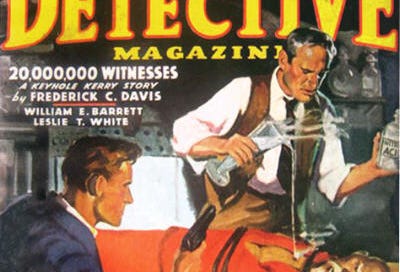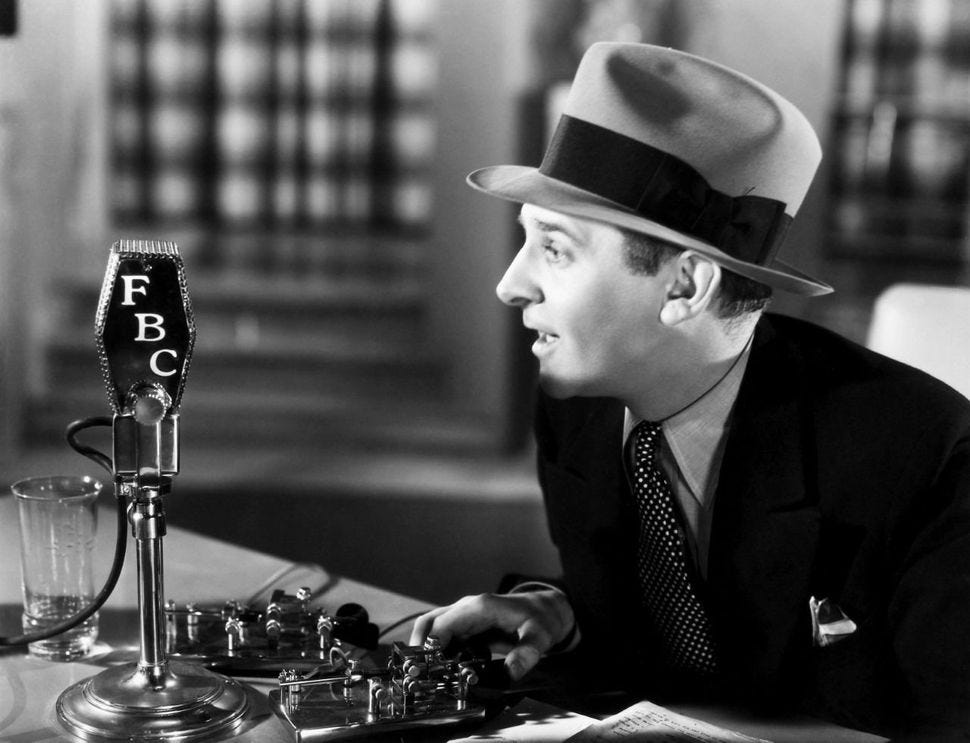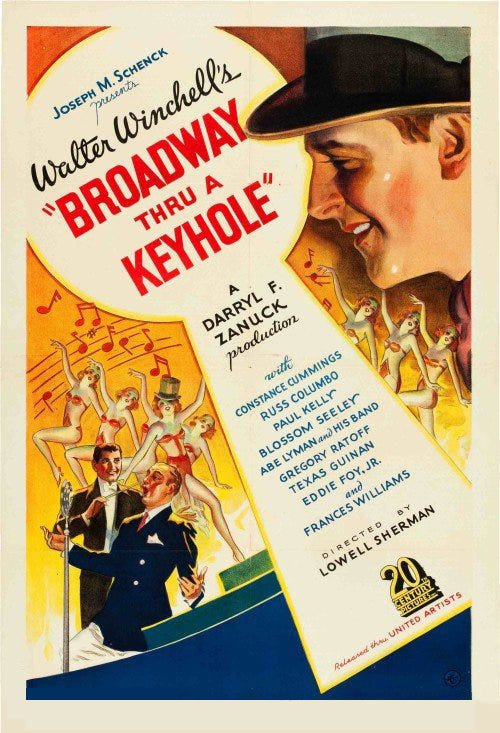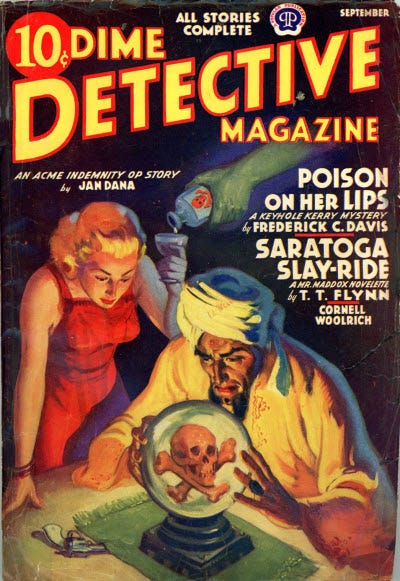Frederick Davis was a prolific pulpster who wrote mainly in the detective genre. Among his series were half of the “Operator # 5” novels (under the house name of Curtis Steele), the “Moon Man” series, “Secrets, Inc.”, “Ravenwood, Stepson of Mystery,” “Bill Brent,” and others. I love Davis’ writing. He plots a good story and his scenarios are thrilling. He’s excellent at writing psychological drama and not too shabby at supernatural plots, either. One of his lesser known series was, “Keyhole Kerry.” There were eight stories in the short run beginning in 1936 and running periodically until 1939. Almost all them appeared in Dime Mystery Magazine. At the time, the character of Guy “Keyhole” Kerry would have been immediately recognizable to readers. Why? Because he was closely modeled after Walter Winchell.
Walter Winchell (1872-1972) was the inventor of the modern gossip column. He played with language by intermingling wordplay, obscure facts, philosophical observations, and tidbits about business, finance and the underworld with his core material of intimate news about celebrities. He made up his own vernacular, a sort of “slanguage.” It was fashioned from the parlance of journalists, Broadway show people, bootleggers and gamblers. Winchell’s delivery style was brisk, brash, and racy. He invented new and catchy phrases some of which are still in use today. “Tell it to the judge” was one of his, as was, “making whoopie/whoopee.” Describing the birth of a baby as a “blessed event” is also attributed to Walter Winchell.
Winchell’s radio career began in 1930. In 1932, he introduced a weekly radio program which translated his dynamic newspaper style into the new medium. He spoke with the rapidity of a machine-gun-burst and was accompanied by the sound of a telegraph key. His distinctive opening: “Good evening, Mr. and Mrs. North America, and all the ships at sea…” —became world-famous. In the 1930’s and 1940’s Walter Winchell was likely the most popular and influential newsman in the world.
In 1933 he wrote a movie musical called—“Broadway Thru A Keyhole”—obviously referring to getting hold of juicy gossip by listening at keyholes.
With all that in mind let me properly introduce you to Guy “Keyhole” Kerry, a galvanicly nervous young man with a characteristically abrasive voice and prematurely white hair. Although it varied with the circumstances of the story, here is one of his opening radio addresses: “Attention, Mr. and Mrs. America (alternately—Mr. and Mrs. United States)! This is Keyhole Kerry, your scoop specialist, once more beating the nation’s headlines with his exclusive inside chatter. Flash...!” With an address like that, no contemporary reader would have doubted, for a moment, that Winchell was Guy Kerry’s inspiration.
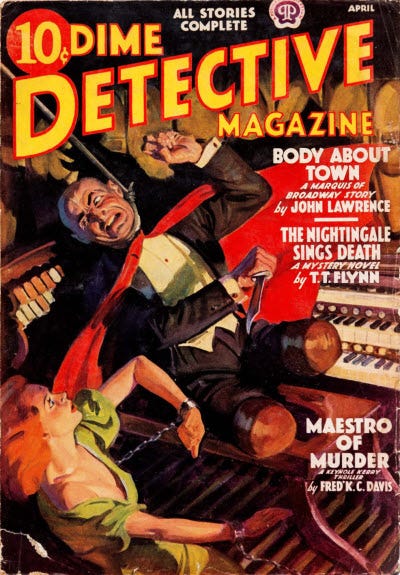
Kerry lives for news, he prides himself on never missing a show and has a special arrangement with the radio station so that he can call in at any time from any phone and be connected on the air, even if it breaks into another program. Print newshawks hate him as he invariably beats them to the punch every time.
Guy Kerry has a beautiful secretary named, Eve Vane, who has full lips, champagne-colored hair, and turquoise eyes. Trying to keep Kerry’s show, and Kerry himself, alive and on the air keeps her rail thin with a perpetually nervous stomach, requiring regular doses of bicarbonate.
Kerry has an antagonist in Police Commissioner Endicott, who’s constantly frustrated by Kerry’s crime “scoops” and is always looking for a way to hang the reporter up to dry.
The Keyhole Kerry stories are fast-moving and exciting. The character of Guy Kerry is well drawn and his adventures are top-notch pulp. Over the course of the series he gets mixed up in kidnappings, murders, a city-wide extortion racket, is accused of a running a massive blackmail scheme over the air, and runs afoul of the District Attorney’s special project. He goes to Hollywood and becomes embroiled in several murders, and comes close to a nervous breakdown while filming his part in a movie.
When I started the series I never expected to like it as much as I did. I was carried away by the action, plots, and by Guy Kerry himself who is one hell of a dedicated reporter.
Here is the full list of the Keyhole Kerry stories:
“20,000,000 Witnesses” (Ace-High Detective, December 1936) reprinted in Dime Detective in December 1950 as “Tune in to Murder.”
“Murder Made Easy” (Dime Detective, May 1937)
“Crimson Broadcast” (Dime Detective, March 1938)
“Maestro of Murder” (Dime Detective, April 1938)
“Double Deadline” (Dime Detective, June 1938)
“Burial Party” (Dime Detective, September 1938)
“The Ghoul Hangs High” (Dime Detective, December 1938)
“Poison On Her Lips” (Dime Detective, September 1939)
The entire series has been collected into two volumes by Steeger Books which can be purchased either on at their website or on Amazon .
As a final side note, Winchell’s gift for creating new “slanguage” must have been studied and appreciated by Robert Leslie Bellem, as well. I find Bellem’s use of language the most unique of all the pulpsters. Although you could argue that all gifted detective writers use very specific verbiage, Bellem twisted words and meanings in a similar way to Walter Winchell. To me, he was definitely following in Winchell’s typewriter tracks. To find out more about Robert Leslie Bellem’s use of language see my earlier post, “Pulp Palaver: Co-Starring Dan Turner, Hollywood Detective.”
This is the Rocketeer signing off for today.


